
Ditch the stress. Gain control. Spend smarter.
📍 Why Tracking Your Spending Matters
Budgeting doesn’t have to be a spreadsheet marathon.
You don’t need to be an accountant or finance expert to stay on top of your spending. Knowing where your money goes gives you:
- More control over your finances
- Clarity about your habits
- The freedom to make intentional choices
- A way to stop the “Where did it all go?” cycle
✅ Step 1: Start Small — Really Small
✨ Focus on One Category
Don’t overwhelm yourself trying to track everything. Instead:
- Pick one category — like dining out, subscriptions, or impulse buys.
- Track only that category for 1–2 weeks.
- Ask: Is this how I want to use my money?
👉 Keyword Tip: People searching “how to start budgeting” or “easy budget tips” are likely overwhelmed — this is the hook that pulls them in.
⚙️ Step 2: Use Tools That Do the Work for You
💻 Let Apps Automate It
No need to log every coffee. These apps connect to your bank and do the hard part:
🟢 Mint (Free)
- Easy setup, automatic categories
- Great overview of where money’s going
🔵 You Need A Budget (YNAB)
- Helps you assign every dollar a job
- Ideal for intentional, proactive budgeting
🟣 PocketGuard
- Tells you what’s “safe to spend” after bills
- Super simple and beginner-friendly
Bonus tip: Try a few and see which feels the least stressful to check regularly.
📆 Step 3: Set a Weekly “Money Check-In”
🗓️ Pick a Day — Make It a Ritual
Instead of obsessively tracking daily, schedule a 10-minute check-in once a week.
- Sunday evening? Cup of tea + budget = chill.
- Monday morning? Quick glance before the week starts.
Ask yourself:
👉 “Does my spending reflect my priorities?”
That one question builds financial awareness faster than any budget rule.
🚫 Step 4: Don’t Chase Perfection
🧘♀️ Progress > Perfection
You’re not here to judge yourself. You’re here to learn.
- Forgot to track for a few days? No problem.
- Overspent in one category? That’s insight — not failure.
What matters:
- Noticing patterns
- Adjusting with intention
- Being kind to yourself
Tracking isn’t about guilt — it’s about awareness.
🎨 Step 5: Make It Visual (and Maybe Fun)
🖍️ Visuals Help You See Spending Habits
If you’re a visual learner:
- Use color-coded budgets (red = overspend, green = under budget)
- Watch progress bars fill up in your app
- Use charts, stickers, or even emojis
Bonus: Get creative with spreadsheets or printable trackers.
Visual cues = higher motivation.
🟡 Want one done-for-you? Grab the free tracker template at the end.
🥳 Step 6: Celebrate Every Win
🎉 Small Steps Count
Tracked for 3 days straight? That’s a win.
Noticed a habit you want to change? Also a win.
Create mini-rewards:
- Budget-friendly treat (like your fave coffee)
- Fun sticker on your tracker
- Share your win with a friend or accountability buddy
Progress fuels consistency.
🔁 Recap: Your Low-Stress Spending Plan
| Step | What to Do |
|---|---|
| 1️⃣ | Track ONE category first |
| 2️⃣ | Let apps do the tracking |
| 3️⃣ | Choose a weekly review day |
| 4️⃣ | Aim for progress, not perfection |
| 5️⃣ | Use visuals to stay motivated |
| 6️⃣ | Celebrate your consistency |
💡 Extra Tips to Make Tracking Even Easier
📲 Set App Notifications
Get reminders you actually like — not annoying alerts.
🤝 Get an Accountability Buddy
Text a friend, “Checking in on my spending!” once a week.
You’ll both win.
✏️ Customize Your Categories
Tailor them to your life — not someone else’s idea of a perfect budget.
🔚 Final Thoughts: It’s About Empowerment, Not Rules
You don’t need to be a finance nerd.
You don’t need to track every dollar to make progress.
You just need to start small and keep going.
Money clarity = life clarity.
Tracking your spending is the first step to financial calm.
📥 Freebie: Download Your No-Stress Spending Tracker
Get a clean, easy-to-use template to start tracking today — no fancy formulas or math skills required.


